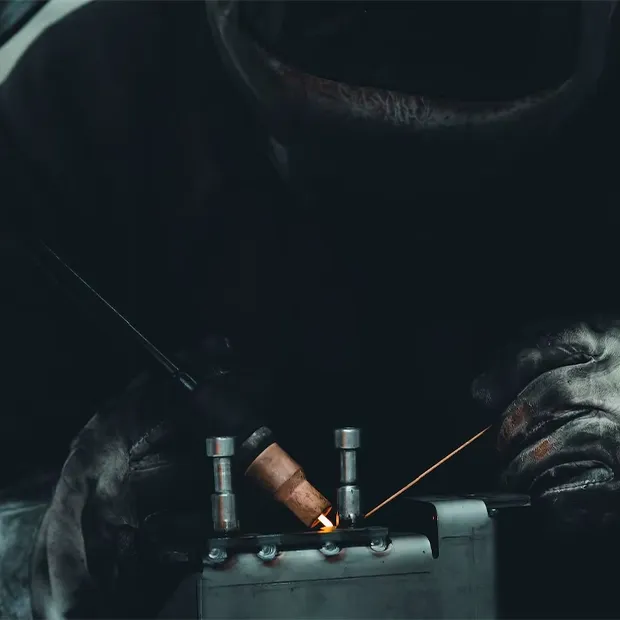TIG Welding Wire
TIG welding wire is a consumable material that provides durable and aesthetic results in metal joining processes. This method allows for strong and smooth connections between different types of metals. Thanks to the controlled transfer of the melting wire into the weld pool, balanced, smooth, and clean seams are achieved. This feature offers a significant advantage in thin material welding.
TIG welding wire is one of the key components that directly affects weld quality. The right wire selection should be made according to the material type, thickness, and field of application. The wire’s surface cleanliness and diameter also play a decisive role in the durability of the result. These wires are widely used in industrial production and the automotive sector, providing high-strength joints when used with the correct current settings.
The main materials suitable for this method are:
Commonly used in the automotive and aviation industries due to its lightness and high conductivity.
Preferred in food, chemical, and medical equipment production because of its corrosion resistance.
Requires careful current control during welding due to its high heat conductivity.
Wires with dirty or oxidized surfaces may negatively affect weld quality.
Frequently welded in aircraft parts and medical implants thanks to its strength and lightness.
Used in energy and petrochemical plants due to their resistance to high temperatures.
TIG Welding Wire Prices
The price of TIG welding materials varies depending on the type of material used, wire diameter, and manufacturer brand. This welding method is preferred for applications requiring high precision to achieve clean and strong seams.
The quality of the wire directly affects both welding performance and cost. Selecting the right wire for the metal type is also crucial for ensuring a long-lasting bond.
TIG welding wire prices are generally determined per kilogram, and the alloy ratio is one of the most important factors influencing the cost. The use of argon gas as a shielding gas during welding improves seam quality while preventing surface oxidation, ensuring professional results. When choosing the type of wire, project requirements and cost balance should be considered.
Main factors affecting prices include:

When determining TIG wire prices, not only cost but also welding quality should be considered. With the right combination of wire and gas, work efficiency increases, and the weld maintains its durability in the long term. Therefore, in professional welding applications, proper material selection is a key factor both in terms of cost and quality.
Aluminum TIG Welding Wire Prices
For businesses aiming to balance productivity and quality in industrial production, aluminum welding wire prices are an important criterion. Prices vary depending on raw material purity, production technology, and global metal market values.
The lightweight and high conductivity of aluminum make these wires a sought-after welding consumable across different industries. In aviation, automotive, and energy equipment manufacturing, they are carefully evaluated for cost optimization.
The factors affecting price differences are not limited to production costs. The structural features of the wire, coating method, and application area also play a decisive role in the total cost:
- Wires with electrode rod (ER) standards offer high melting stability and clean seam quality.
- Some wires are strengthened with copper coating to enhance surface conductivity.
- As the wire diameter increases, consumption decreases, but welding speed and control sensitivity change.
- Wires with shorter cooling times save time on production lines.
- Wires made from high-purity aluminum are more resistant to oxidation.
- Packaging and storage conditions affect the wire’s moisture content and surface quality.
- Exchange rate fluctuations directly impact the prices of imported wire types.
When selecting aluminum welding wire, not only the cost but also longevity, welding efficiency, and seam quality should be taken into account. Choosing the right wire shortens production time and minimizes post-weld surface finishing needs, providing both economic and technical advantages for businesses.
Frequently Asked Questions
It is a filler material that enables the joining of two metal surfaces under high temperature. It melts during application to complete the weld seam and enhances both the durability and appearance of the connection.
Yes, this method is generally performed using a noble gas called argon. Argon protects the welding area from the oxygen in the air, resulting in a clean and shiny weld.
The TIG method uses a tungsten electrode and is performed under a shielding gas. The MIG method, on the other hand, uses a wire feed, operates at higher speed, and is generally applied in automated systems. Although both use shielding gases, their wire and current structures differ.
This type of welding can be successfully applied to aluminum, stainless steel, nickel, titanium, and carbon steel. Because it provides controlled heat distribution in thin sections, it is especially preferred in precision manufacturing.
Tungsten-based electrodes are used in TIG welding. These electrodes do not melt; they only create the arc. Depending on the application area, pure tungsten, thoriated, or zirconium-added types may be preferred.
To learn about TIG welding wires and find the most suitable solutions for your application needs, you can contact Eko Kaynak.

